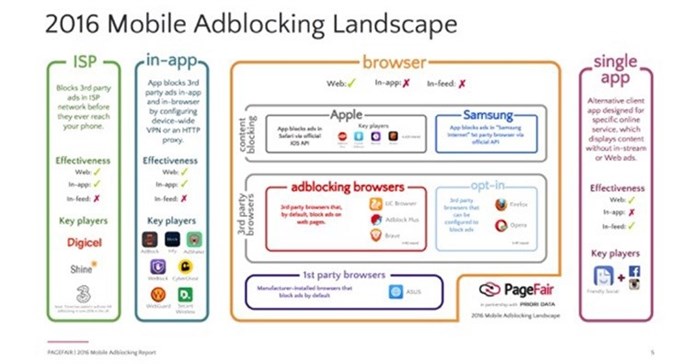





Many publishers and advertisers have hoped that mobile platforms and walled gardens would offer a refuge from adblocking. As our latest report shows, this is not the case.
At PageFair, our intention is to re-establish a fair deal between publishers and content consumers. Our latest research shows how important that mission is becoming. The blocked web is going mobile, in a surprising way.

We parsed the description data of thousands of apps and conducted user testing of several hundred of these apps to determine their functionality to build a picture of all adblocking apps and their features. We explored the numbers of app downloads from over 100 Google and Apple app stores across the globe in partnership with Priori Data, and drew data from StatCounter’s network of over 3 million websites.
Here are the key findings of our research:
Summarised, 20% of the world’s smartphone users are using mobile adblocking browsers, which are mobile browsers that block ads by default. This is an order of magnitude greater than many had believed.
In the West, mobile adblocking is not yet mainstream, and desktop adblocking is far more popular. There are 14 million monthly active users of adblocking browsers in Europe and North America, plus an additional 4.9 million content blocking and in-app adblocking apps downloaded from app stores in Europe and North America since September 2014.
This is the start of something that will grow as more device manufactures and web browsers follow the example of Apple, Samsung, ASUS, and browsers such as Opera. Our warning in this report is similar to those we gave in 2013 and 2014 regarding desktop adblocking, which has now become mainstream.
In contrast, publishers in the Asia-Pacific region are already feeling very significant losses from mobile adblocking. Hundreds of millions of users are today using mobile browsers that block by default.
Globally the message is that mobile, which agencies and publishers both view as a growth platform, has the same challenges as desktop. The Blocked Web — the portion of the web where people are blocking — is now both mobile and desktop, and this will be increasingly apparent to Western publishers over time.
Until now there was an assumption that ads in apps were invulnerable to blocking. This is not the case. Walled gardens such as Facebook, Instagram, Apple News, etc., are no longer invulnerable.
For the most part what we are talking about are blocker apps that control device network connections, although there are other approaches. These apps put the user in control of what they see on their device.
As the PageFair Mobile Adblocking Landscape shows, there are many methods by which a wide spectrum of parties can block ads.
Only 4.5 million people have downloaded a ‘content blocker’ for an Apple device, despite the hype that greeted Apple’s announcement of this new functionality in iOS9 in September 2015. However, both Apple and Android users are finding other ways to block ads on their devices.
Taken together, these findings show that the ‘Blocked Web’, the portion of the web where users block ads, is steadily growing. While this is causing short-term pain to publishers, it actually opens up a new and entirely uncluttered (and zero fraud) segment that publishers can enable brands to reach with ad serving technology.
There are now two categories of user on the web:

Publishers are taking two contrasting approaches to this situation. One approach is to prevent visitors from entering one's website until they switch off their adblockers, similar to a paywall. The other is to serve ads in a manner that adblockers are unable to circumvent, and to do so in a way that solves the speed, privacy, and UX issues that cause adblocking in the first place.
The first approach — ‘the adblock wall’ — causes many users to simply leave the site, and restricts users’ choice on the web. In the short term, it may be useful to ask a small set of users to opt in to ads, but this approach is not sustainable over the medium and longer term.
The second approach is to show respectful ads in a way that cannot be circumvented by adblockers, but which address the genuine problems that drove users to install adblockers. This fixes the consumer issues and gives the publisher a new premium segment to sell.
Source: INMA.org.